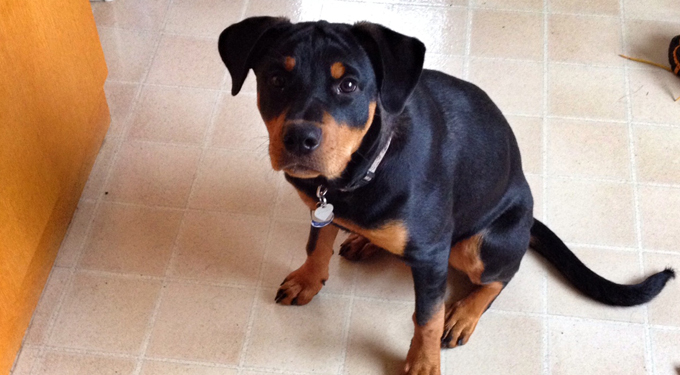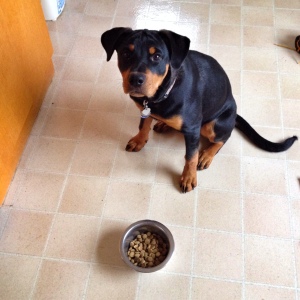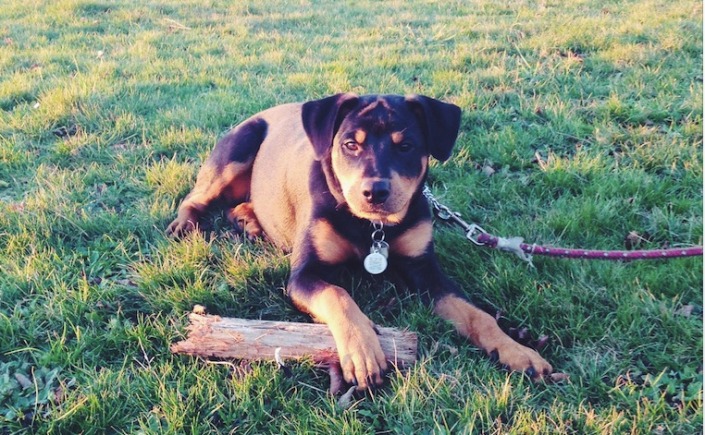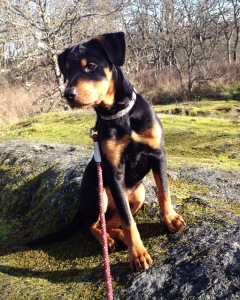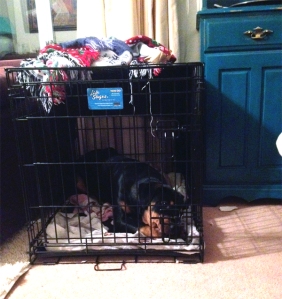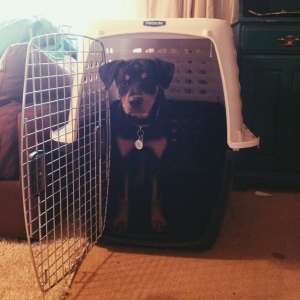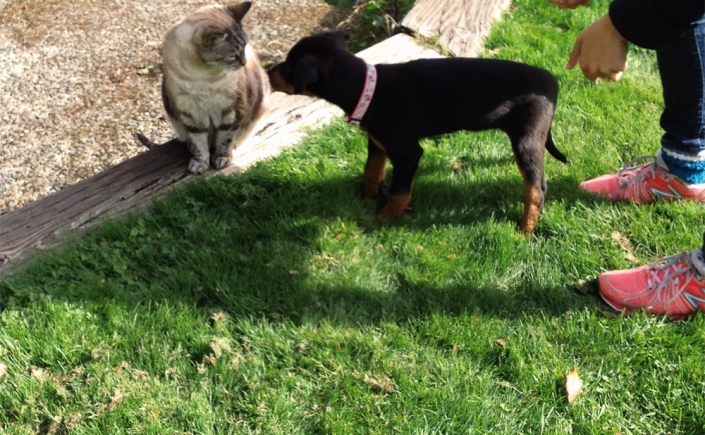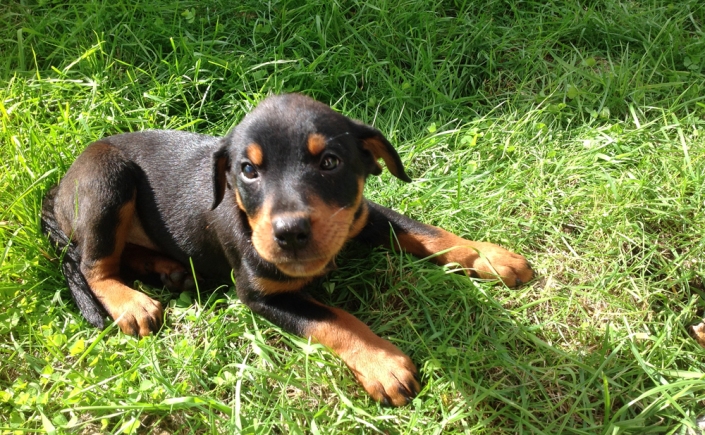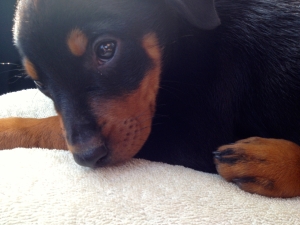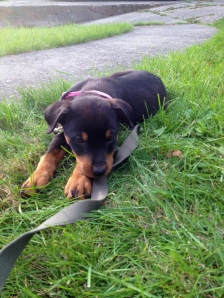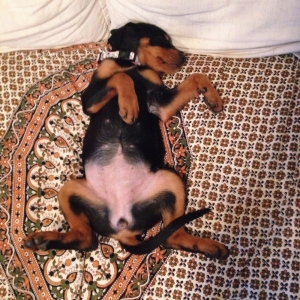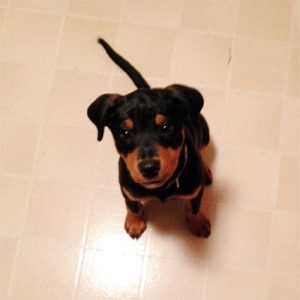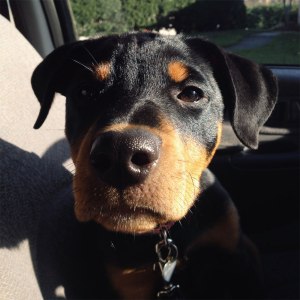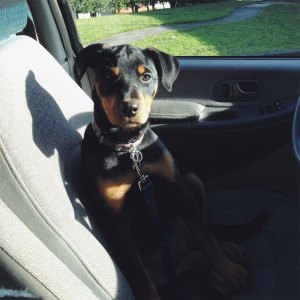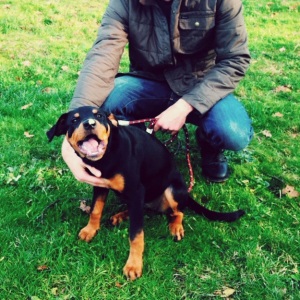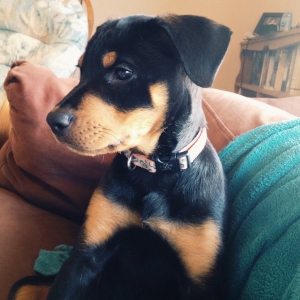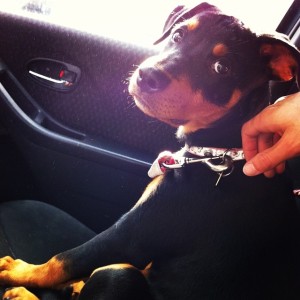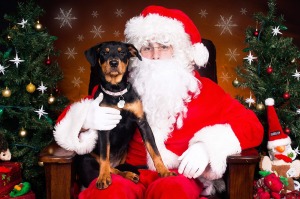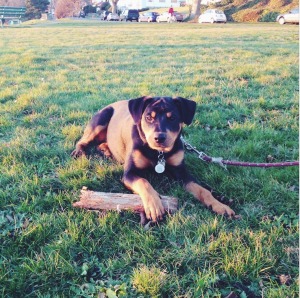It was very important to us that we socialize and condition Betsy as much as possible.
What is socialization and conditioning?
Socialization – Getting your puppy used to as many people, children, dogs, cats, horses, and other living creatures as possible.
Conditioning – Getting your puppy used to as many weird objects and environments as possible, like walking on bridges and weird surfaces, traffic, funny hats, loud noises, etc.

Betsy attending puppy socialization class.
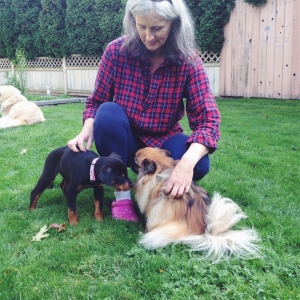
Betsy meeting Angel, my mom’s older and somewhat crotchety pomeranian.
We did a ton of research on these two topics before getting a puppy, and there are a bunch of things that we learned:
- Socialization and Conditioning can and should continue throughout a dog’s life. however, a there is a small window of time in a puppy’s life that makes a huge difference: the first 16 weeks.
- It’s important that the experiences your puppy has during this time are positive and not overwhelming.
- It’s important that your puppy meets as many people and other dogs, etc as possible, and that her interactions with them shows her that these creatures are really wonderful and fun.
- Socialization is an EXTREMELY IMPORTANT aspect of raising a happy and well-balanced dog.
- There are hundreds of articles on puppy socialization online that detail all this at length, so I will link you to a few if you’re interested: How to socialize your puppy, Puppy socialization, Puppy socialization is part of raising a perfect puppy.
- Another really important thing for a puppy to learn is bite inhibition, which is also learned during a puppy’s first 16 weeks of life. You want your dog to have the softest bite possible so that she doesn’t hurt other dogs or people in the future. Bite inhibition is best learned by playing with other dogs: They play, a dog bites to hard, the other dog yelps and stops playing, the dog learns that she needs to not bite as hard in the future.
- Finally, you want your puppy to learn about other dogs’ body language – Play moves, calming signals, etc.
- All of these are reasons why socialization is extremely critical 🙂
Unfortunately, puppies also go through something called a fear period between 8 and 12 weeks of age, where scary things can traumatize them and affect them for the rest of their lives. So while you socialize them you also have to be EXTRA careful that you don’t expose them to anything terrifying. A lot of responsibility, and we were so so paranoid.
(pro tip: If your dog is scared of something, the best way to deal with it is to approach the scary object and interact with it, to show your dog that there’s nothing to worry about. Do not comfort your dog, as this just tells them that they’re right for being afraid!)
Betsy’s Socialization Adventures
Needless to say, we did our absolute best to socialize Betsy well, and continue to do so, even though she’s past the critical phase. I don’t know how well we did, and probably won’t until she’s a bit older, which is when you can start to see the effects of things you might have missed out on. However, I don’t think we could have done anything more, so no regrets!
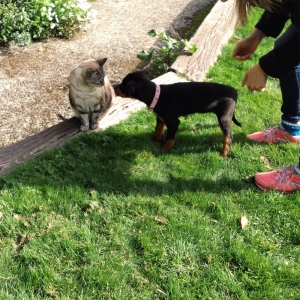
Betsy meeting her first cat, a friendly/slightly senile old cat that belongs to my parents.
Here is some of the stuff we did:
- Puppy socialization classes – This was a big part of our socialization plan, and I’m so so glad that we did it. When we first started going, Betsy was really nervous. It took about 6 classes for her to come out of her shell, but we kept it up and now she absolutely LOVES going to class (we still attend a few times a week, since she has so much fun there). These are classes put on in our local pet stores by a professional trainer. Puppies 8 months and under are thrown in a pen together and given a chance to play. This is where Betsy has met the majority of other dogs, has practiced bite inhibition, play regulation, and responding appropriately to other dogs’ signals.
- Meeting kids – My boyfriend is the manager of an after school care program, which is awesome for socializing Betsy with kids. Betsy went to work with him for the first 3 months that we had her, and he made sure she had positive interactions with kids of all ages every day. Again, she was a bit scared at first, but now whenever we pass kids on one of our walks, she is dying to go say hello to them!
- Meeting elderly people- At my boyfriend’s work, there is also a seniors’ centre, so he would take Betsy there on his lunch breaks to meet with the residents there. There she got to experience canes, walkers, wheelchairs, etc, and learned that old people are awesome (and they loved visiting with a puppy, so it was win-win!)
- The world in general- We take Betsy with us as much as we can. We often go downtown for coffee, so we’d take her with us and let her hang out on the patio (with us, not alone of course) while we drink our coffee. All sorts of people are downtown, and they all like to say hi to a cute puppy, so she got to experience a ton of different types of people, as well as lots of traffic and interesting noises and smells.
- Cats – This was tricky, but we managed to introduce Betsy to five different cats, all of them with completely different personalities. One was my mom’s senile old cat who seems to be completely unaware of what’s going on half the time. She let Betsy sniff her at length before wandering off. Another was my mom’s younger, spunkier cat, who growled at Betsy and bolted, much to Betsy’s surprise! My boyfriend’s brother has two cats, one that Betsy kept trying to play with, and another that tried to scratch Betsy when she walked by. And finally, a cat we encountered on one of our walks, who simply stared at Betsy in disdain when she gave it a play bow.
- Horses- Betsy saw a few horses from a distance when we first got her and took her to a farm, but I wish we could have done more 😕 I don’t think she’s well socialized with farm animals, unfortunately.
- Having people over and going to other peoples’ houses – Betsy has experienced lots of both. ‘Nuff said.
Strange observations when socializing
When Betsy feels overwhelmed or scared, her immediate reaction is to beg to be picked up. I don’t know where she got this behaviour from, it seems to just come to her naturally. She did this around traffic, other dogs, and kids when we first got her, although she has since gotten over this and loves all three of these things (almost too much! More on that in another post…)
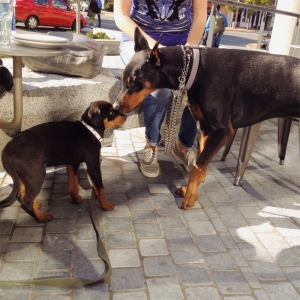
Betsy on one of her downtown adventures, looking a little nervous while meeting a friendly Doberman.
As she’s gotten older, she has gained so much confidence. I don’t know if this is related to her age or due to us raising her confidence through ample socialization. Or maybe a mix of both. Betsy is virtually never scared now. I recently watched her pop a balloon and not even flinch at the bang, while my mom’s older pomeranian scooted off in fear at the noise!
One thing we were always worried about was traumatizing her. Especially during puppy socialization class, where she seemed SO TERRIFIED at first. I actually emailed the trainer after her first class, worried that we were scarring her for life by bringing her, but she encouraged us to continue coming, and it turned out to be a good idea.
I don’t worry about this so much anymore, although I do live in fear that a dog will run up and bite her on a walk or a stranger will abuse her and trigger fear aggression later in life 😦 I do my best to not approach other dogs without checking with the owner first, and carefully watching their signals to make sure things are going ok. It’s hard because Betsy is totally clueless, and will jump playfully all over a dog that is giving off every warning sign in the book if I let her (I don’t!)
Recently, Betsy had two unpleasant interactions, one with a dog and one with a human. The dog was at a dinner party. The owners assured us it was a friendly dog, it turned out it wasn’t 100% friendly, and it bit Betsy not once, but TWICE. Neither bite broke the skin, and Betsy seemed to come out of it unscathed emotionally (fingers crossed). I’m hoping it was a good lesson for her not to be too pushy with other dogs, and that the fact that the dog obviously refrained from biting TOO hard gives me hope that she saw it as a correction and not as a totally terrifying event.
The other was with a person (what?!) who thought he was some kind of dog expert, and grabbed her by the scruff of the neck and wrestled her to the ground, SHOUTING, when she jumped up in hello. We don’t encourage Betsy to jump, and we always correct her for doing so, but our corrections involve pushing her off and turning our backs, not wrestling her down and holding her there! I was livid with him and I still regret not saying something 😕
Our adventures in socialization continues!
